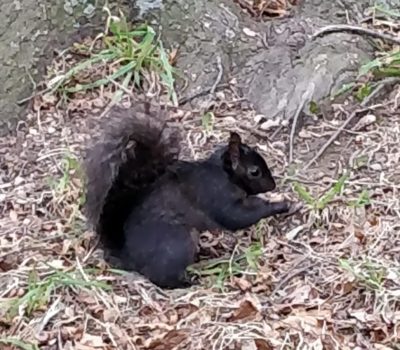Cities offer an unprecedented global experiment for parallel evolutionary change: they similarly differ in several dimensions including climate, land cover, and pollution. Yet few studies examine evolutionary change across multiple cities, which is critical for identifying environmental characteristics that mediate adaptive responses. For example, city size, age, and habitat connectivity may all contribute to the strength of urban-associated phenotypic clines, and regional patterns of environmental variation (e.g., climate) can mediate parallelism at larger spatial scales.
In their recent study, published in Scientific Reports, Bradley Cosentino and James Gibbs, leverage community science data of more than 60,000 squirrels from 43 North American cities to test if melanic coat color correlated with urbanization. (We previously told you about the preliminary findings from this exciting work.) Specifically, the authors test for parallel evolution of melanic coat color in Eastern Gray Squirrels (Sciurus carolinensis) and explore the mediating factors that might explain non-parallel clines.
Melanism in squirrels is a genetically based trait that is related to both thermoregulation and crypsis. Previous work on squirrels in Syracuse, NY, and in Wooster, OH, suggests that the melanic morph might be more common in cities versus exurban areas because of divergent selection associated with crypsis, predation, and road mortality. However, it remained unknown if this was a general trend associated with urbanization across diverse North American cities.

Cosentino and Gibbs found that prevalence of melanic coat color increased with impervious surface cover, a proxy for urbanization, across multiple cities. This relationship hints at a potential agent of selection: crypsis. In non-urban environments, predation and hunting are the main causes of squirrel mortality, and the gray morph provides suitable camouflage in forested habitats. This selection pressure likely declines as forest cover decreases, coincident with an increase in another selective pressure: road mortality. The melanic morph, it turns out, is more visible on asphalt roads compared to the gray morph, giving it a selective advantage in an environment where vehicle collisions are the number one source of mortality.

Of course, the prevalence of melanism in urban areas might also be a result of non-adaptive processes. Human-mediated introductions across cities combined with restricted gene flow and reduced genetic diversity as a consequence of founder events could produce urban-associated clines, particularly in traits like melanic coat color that are determined by a single locus. However, the authors argue that founder effects are not the driving force behind the detected patterns. In cities at northern latitudes, the melanic morph was historically common in rural forests and has only shifted in prevalence as human populations (and associated deforestation and infrastructure development) have increased in North America over the past century. Nevertheless, genetic analyses are needed to clarify the underlying population structure and rule out alternative explanations for the observed clines.

Cosentino and Gibbs also found that the strength of urban-rural clines in coat color varied. One explanation for this pattern is temperature: cities with warmer winter temperatures had weaker relationships between melanism and urbanization. Melanic coats are maintained in colder climates because they generate and retain more heat than gray coat color. However, this advantage disappears in the warm-winter southern cities, which the authors suggest might limit melanism despite other selective pressures associated with urbanization. The authors also found that the strength of urban-rural clines was positively associated with city size and urban tree cover. These findings warrant further investigation to understand how they might relate to adaptive and non-adaptive processes across the urban-rural gradient.
By examining so many cities, Cosentino and Gibbs were able to detect both parallel and non-parallel phenotypic changes in response to urbanization and to tease apart potential selective agents contributing to these patterns. They were able to do this by leveraging community science data through their SquirrelMapper project. Although community science approaches may introduce biases (e.g., rare color morphs may be more likely to be photographed), accumulating such a large sample size across so many cities would be nearly impossible using traditional sampling methods. These resources help build connections with the urban communities in which we work, and open the door to answering exciting questions with the power of large sample sizes across large geographic ranges.
Read more about this study:
Cosentino, B. J., & Gibbs, J. P. (2022). Parallel evolution of urban–rural clines in melanism in a widespread mammal. Scientific reports, 12(1), 1-7.
Featured image: melanic squirrel in Princeton, New Jersey, by K. Winchell (CC-BY-NC)
- New Lit Alert: Urban environment determines population genetics in the green toad, Bufotes viridis - September 11, 2023
- Contribute to the New York Canid Project! - July 21, 2023
- Parallel Urban Adaptation from Phenotype to Genotype in Anolis Lizards - January 19, 2023

Leave a Reply